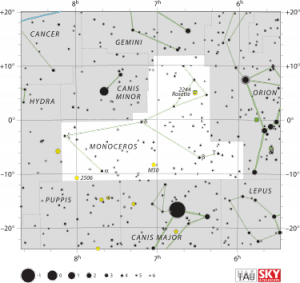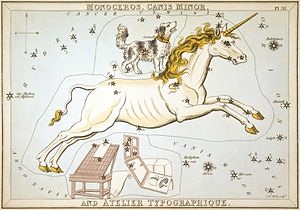Monoceros
Monoceros is a faint constellation on the celestial equator. Its name is Greek for unicorn. Its definition is attributed to the 17th-century Dutch cartographer Petrus Plancius. It is bordered by Orion (Constellation) to the west, Gemini (Constellation)to the north, Canis Major to the south and Hydra to the east. Other bordering constellations include Canis Minor, Lepus and Puppis. Monoceros also contains Plaskett's Star, which is a massive binary system whose combined mass is estimated to be that of almost 100 Suns put together.
Monoceros contains many clusters and nebulae, most notable among them:
- Messier 50, an open cluster
- The Rosette Nebula (NGC 2237, 2238, 2239, and 2246) is a diffuse nebula in Monoceros. It has an overall magnitude of 6.0 and is 4900 light-years from Earth. The Rosette Nebula, over 100 light-years in diameter, has an associated star cluster and possesses many Bok globules in its dark areas. It was independently discovered in the 1880s by Lewis Swift (early 1880s) and Edward Emerson Barnard (1883) as they hunted for comets.
- The Christmas Tree Cluster (NGC 2264) is another open cluster in Monoceros. Named for its resemblance to a Christmas tree, it is fairly bright at an overall magnitude of 3.9; it is 2400 light-years from Earth. The variable star S Monocerotis represents the tree's trunk, while the variable star V429 Monocerotis represents its top.
- The Cone Nebula (NGC 2264), associated with the Christmas Tree Cluster, is a very dim nebula that contains a dark conic structure. It appears clearly in photographs, but is very elusive in a telescope. The nebula contains several Herbig-Haro objects, which are small irregularly variable nebulae. They are associated with protostars.
- NGC 2254 is an open cluster with an overall magnitude of 9.7, 7100 light-years from Earth. It is a Shapley class f and Trumpler class I 2 p cluster, meaning that it appears to be a fairly rich cluster overall, though it has fewer than 50 stars. It appears distinct from the background star field and is very concentrated at its center; its stars range moderately in brightness.
- Hubble's Variable Nebula (NGC 2261) is a nebula with an approximate magnitude of 10, 2500 light-years from Earth. Though it is named for Edwin Hubble, it was discovered in 1783 by William Herschel. Hubble's Variable Nebula is illuminated by R Monocerotis, a young variable star embedded in the nebula; the star's unique interaction with the material in the nebula makes it both an emission nebula and a reflection nebula. One hypothesis regarding their interaction is that the nebula and its illuminating star are a very early stage planetary system.
History
Monoceros is a relatively modern constellation. Its first certain appearance was on a globe created by the Dutch cartographer Petrus Plancius in 1612 or 1613[7] and it was later charted by Jakob Bartsch as Unicornu on his star chart of 1624. Heinrich Wilhelm Olbers and Ludwig Ideler indicate (according to Richard Hinkley Allen's allegations) that the constellation may be older, quoting an astrological work[10] from 1564 that mentioned "the second horse between the Twins and the Crab has many stars, but not very bright"; these references may ultimately be due to Michael Scot of the 13th century, but refer to a horse and not a unicorn, and its position does not quite match. Joseph Scaliger is reported to have found Monoceros on an ancient Persian sphere. [Camille Flammarion] believed that a former constellation, Neper (the "Auger"), occupied the area of the sky now home to Monoceros and Microscopium, but this is disputed.[1]
Mythology
The unicorn (Latin unus 'one' and cornus 'horn') is a mythical beast depicted with the body of a horse and a spiral horn on its forehead. The unicorn's horn was said to have the property of being able to neutralize poisons. The picture of a Unicorn was the apothecaries' symbol. The powdered root of the 'unicorn horn' was believed to be a panacea for just about all illnesses. Ancient Greek writers associated the unicorn with the Hippoi Monokerata, One Horned Asses, in which it is said "the fabulous unicorn of Medieval bestiaries was derived from this creature of Greek legend." [2]
HGS Sessions
HGS Sessions - Clearing Himalaya Range- 3/20/2015 [3]
HGS Sessions - Clearing San Francisco Golden Gate Bridge, 55 Reversal Grid - 3/31/2015 [4]
References
Found in HGS Manual on Page 108 Found in HGS Manual on Page 115



